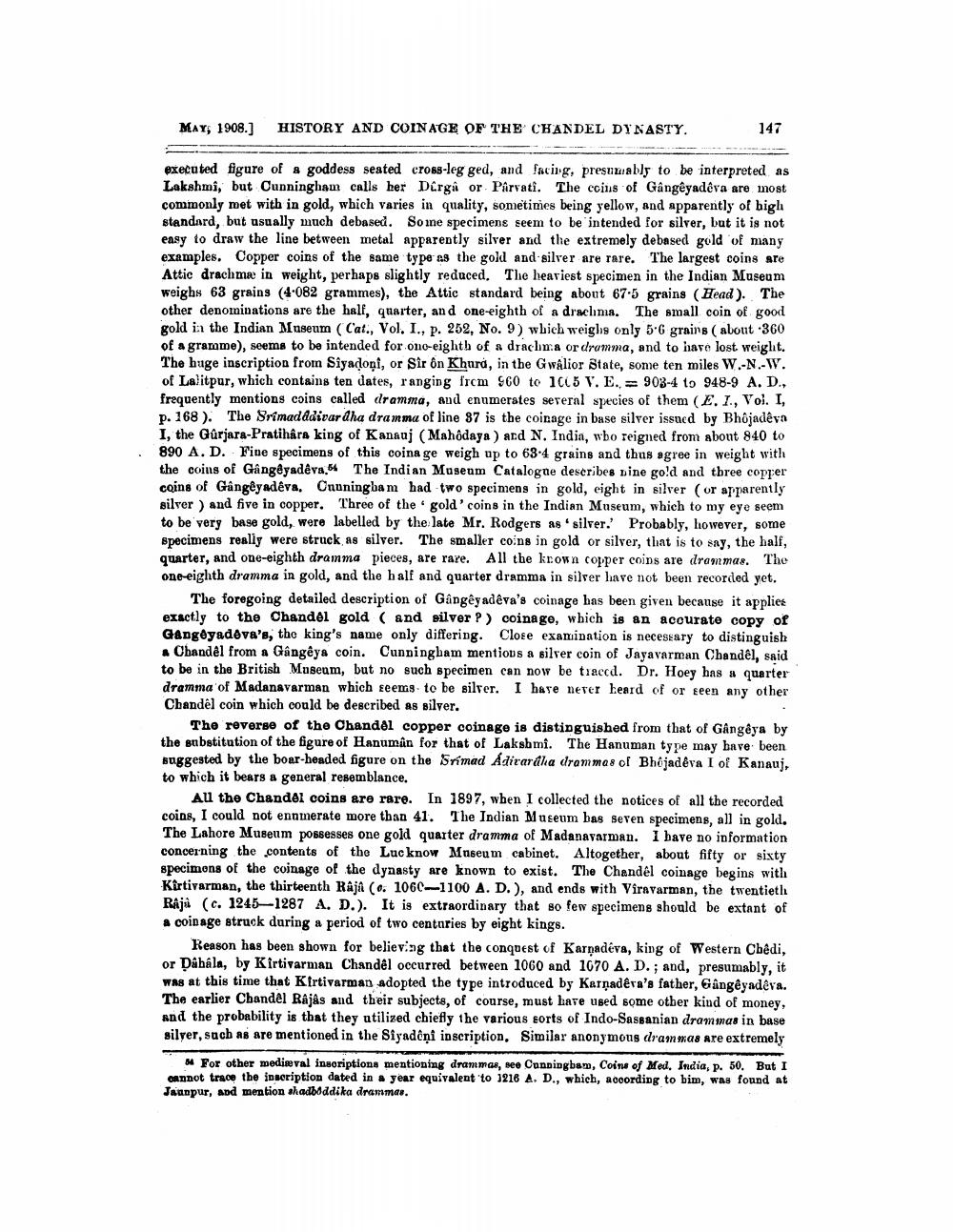________________
MAY, 1908.)
HISTORY AND COINAGE OF THE CHANDEL DYNASTY.
147
executed figure of a goddess seated cross-leg ged, and facing, presumably to be interpreted as Lakshmi, but Cunningham calls her Dergå or Pârvati. The coins of Gang@yadeva are most commonly met with in gold, which varies in quality, sometimes being yellow, and apparently of bigh standard, but usually much debased. Soine specimens seem to be intended for silver, but it is not easy to draw the line between metal apparently silver and the extremely debased gold of many examples. Copper coins of the same type as the gold and silver are rare. The largest coins are Attie drachma in weight, perhaps slightly reduced. The heaviest specimen in the Indian Museum weighs 63 grains (4.082 grammes), the Attic standard being about 67.5 grains (Head). The other denominations are the half, quarter, and one-eighth of a draclima. The small coin of good gold in the Indian Museum (Cat., Vol. I, p. 252, No. 9) which weighs only 5.6 grains ( about 360 of a gramme), seems to be intended for ono-eighth of a drachma or dramma, and to have lost weight. The huge inscription from Siyadoņi, or Sir ôn Khard, in the Gwâlior state, some ten miles W.-N.-W. of Lalitpur, which contains ten dates, ranging from 960 to 1005 V. E. = 903-4 to 948-9 A. D., frequently mentions coins called dramma, and enumerates sereral species of them (E.I., Vol. I, p. 168 ). The Srimadadivardha dramma of line 87 is the coinage in base silver issued by Bhojadêya I, the Gurjara-Pratihâra king of Kanaaj (Mahôdaya) and N. India, who reigned from about 840 to 890 A. D. Fine specimens of this coina ge weigh up to 63-4 grains and thus agree in weight with the coins of Gang@yadêra. The Indian Museum Catalogue describes nine gold and three copper coins of Gang@yadêva, Cunningbam had two specimens in gold, eight in silver (or apparently silver ) and five in copper. Three of the gold coins in the Indian Museum, which to my eye seem to be very base gold, were labelled by the late Mr. Rodgers as silver.' Probably, however, some specimens really were struck, as silver. The smaller coins in gold or silver, that is to say, the half, quarter, and one-eighth dramma pieces, are rare. All the known copper coins are drammas. The one-eighth dramma in gold, and the half and quarter dramma in silver have not been recorded yet.
The foregoing detailed description of Gangéyadeva's coinage has been given because it applies exactly to the Chandol gold ( and silver P) coinage, which is an accurate copy of Gang@yadova's, the king's name only differing. Close examination is necessary to distinguish . Chandel from a Gangêya coin. Cunningham mentious a silver coin of Jayavarman Chandel, said to be in the British Museum, but no such specimen can now be traced. Dr. Hoey has a quarter dramma of Madanavarman which seems to be silver. I have never heard of or seen any other Chandel coin which could be described as silver.
The reverse of the Chandal copper coinage is distinguished from that of Gangêya by the substitution of the figure of Hanuman for that of Lakshmi. The Hanuman type may have been suggested by the boar-headed figure on the Srimad Adirardla drammas of Bhojadêva I of Kanauj, to which it bears a general resemblance.
AU the Chandel coins are rare. In 1897, when I collected the notices of all the recorded coins, I could not enomerate more than 41. The Indian Museum bas seren specimens, all in gold. The Lahore Museum possesses one gold quarter dramma of Madanayarman. I bave no information concerning the contents of the Lucknow Museum cabinet. Altogether, about fifty or sixty specimons of the coinage of the dynasty are known to exist. The Chandel coinage begins with Kirtivarman, the thirteenth Rája (o. 106C-1100 A. D.), and ends with Viravarman, the twentieth Rajů (c. 1245—1287 A. D.). It is extraordinary that so few specimens should be extant of a coinage struck during a period of two centuries by eight kings.
Reason has been shown for believing that the conquest of Karņadeva, king of Western Cbêdi, or Dabala, by Kirtivarman Chandel occurred between 1060 and 1070 A. D.; and, presumably, it was at this time that Ktrtivarman adopted the type introduced by Karmadêra's father, Gângêyadeva. The earlier Chandel Rajás and their subjects, of course, must have used some other kind of money, and the probability is that they utilized chiefly the various sorts of Indo-Sassanian drammas in base silver, such as are mentioned in the Siyadêņi inscription, Similar anonymous drammas are extremely
For other medieval insoriptions mentioning drammas, see Cunningbam, Coine of Med, India, p. 50. But I cannot trace the inscription dated in year equivalent to 1216 A. D., which, according to bim, was found at Jaunpur, and mention shadbiddika drammas.




